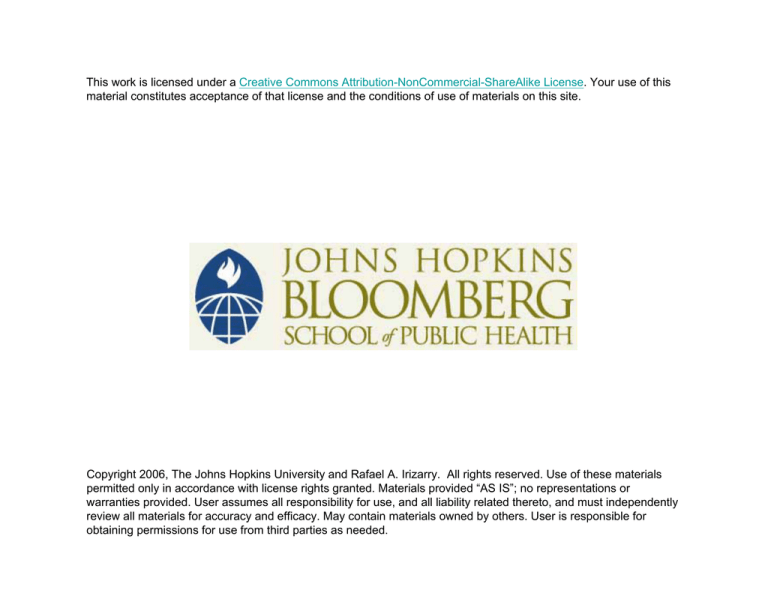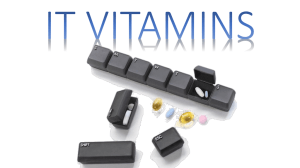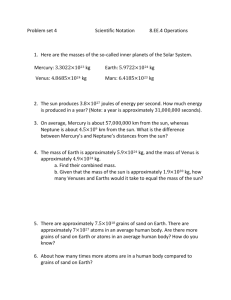
This work is licensed under a Creative Commons Attribution-NonCommercial-ShareAlike License. Your use of this
material constitutes acceptance of that license and the conditions of use of materials on this site.
Copyright 2006, The Johns Hopkins University and Rafael A. Irizarry. All rights reserved. Use of these materials
permitted only in accordance with license rights granted. Materials provided “AS IS”; no representations or
warranties provided. User assumes all responsibility for use, and all liability related thereto, and must independently
review all materials for accuracy and efficacy. May contain materials owned by others. User is responsible for
obtaining permissions for use from third parties as needed.
BIOINFORMATICS AND COMPUTATIONAL
BIOLOGY SOLUTIONS USING R AND
BIOCONDUCTOR
Biostatistics 140.688
Rafael A. Irizarry
Feature Level Data
Outline
• Affymetrix GeneChip arrays
• Two color platforms
1
Affymetrix GeneChip Design
5’
3’
Reference sequence
…TGTGATGGTGCATGATGGGTCAGAAGGCCTCCGATGCGCCGATTGAGAAT…
GTACTACCCAGTCTTCCGGAGGCTA Perfectmatch
GTACTACCCAGTGTTCCGGAGGCTA Mismatch
NSB & SB
NSB
Before Hybridization
Sample 1
Array 1
Sample 2
Array 2
More Realistic
Sample 1
Array 1
Sample 2
Array 2
2
Non-specific Hybridization
Array 1
Array 2
Affymetrix GeneChip Design
5’
3’
Reference sequence
…TGTGATGGTGCATGATGGGTCAGAAGGCCTCCGATGCGCCGATTGAGAAT…
GTACTACCCAGTCTTCCGGAGGCTA Perfectmatch (PM)
GTACTACCCAGTGTTCCGGAGGCTA Mismatch (MM)
NSB & SB
NSB
GeneChip Feature Level Data
• MM features used to measure optical noise and nonspecific binding directly
• More than 10,000 probesets
• Each probeset represented by 11-20 feature Note 1: Position
of features are haphazardly distributed about the array.
Note 2: There are between 20-100 chip types
• So we have PMgij, MMgij
( g is gene, i is array and j is feature)
• A default summary is the avg of the PM-MM
3
Two color platforms
• Common to have just one feature per gene
• Typically, longer molecules are used so nonspecific binding not so much of a worry
• Optical noise still a concern
• After spots are identified, a measure of local
background is obtained from area around spot
Local background
---- GenePix
---- QuantArray
---- ScanAnalyze
GenePix does something different these days
Two color feature level data
• Red and Green foreground and and
background obtained from each feature
• We have Rfgij, Gfgij, Rbgij, Gbgij (g is gene, i is
array and j is replicate)
•
• A default summary statistic is the log-ratio:
(Rf-Rb) / (Gf - Gb)
4
Affymetrix Spike In
Experiment
Spike-in Experiment
•
Throughout we will be using Data from Affymetrix’s spike-in
experiment
•
Replicate RNA was hybridized to various arrays
•
Some probesets were spiked in at different concentrations
across the different arrays
•
This gives us a way to assess precision and accuracy
•
Done for HGU95 and HGU133 chips
•
Available from Bioconductor experimental data package: SpikeIn
Spikein Experiment (HG-U95)
Probeset
A
r
r
a
y
A
B
C
D
E
F
G
H
I
J
K
L
M
N
O
P
Q
R
S
T
1
0
0.25
0.5
1
2
4
8
16
32
64
128
256
512
512
512
512
1024
1024
1024
1024
2
0.25
0.5
1
2
4
8
16
32
64
128
256
512
1024
1024
1024
1024
0
0
0
0
3
0.5
1
2
4
8
16
32
64
128
256
512
1024
0
0
0
0
0.25
0.25
0.25
0.25
4
5
6
7
8
9
10
11
12
13
14
15
16
1
2
4
8
16
32
64 128
0 512 1024 256
32
2
4
8
16
32
64 128 256 0.25 1024
0 512
64
4
8
16
32
64 128 256 512
0.5
0 0.25 1024 128
8
16
32
64 128 256 512 1024
1 0.25
0.5
0 256
16
32
64 128 256 512 1024
0
2
0.5
1 0.25 512
32
64 128 256 512 1024
0 0.25
4
1
2
0.5 1024
64 128 256 512 1024
0 0.25
0.5
8
2
4
1
0
128 256 512 1024
0 0.25
0.5
1
16
4
8
2 0.25
256 512 1024
0 0.25
0.5
1
2
32
8
16
4
0.5
512 1024
0 0.25
0.5
1
2
4
64
16
32
8
1
1024
0 0.25
0.5
1
2
4
8 128
32
64
16
2
0 0.25
0.5
1
2
4
8
16 256
64 128
32
4
0.25
0.5
1
2
4
8
16
32 512 128 256
64
8
0.25
0.5
1
2
4
8
16
32 512 128 256
64
8
0.25
0.5
1
2
4
8
16
32 512 128 256
64
8
0.25
0.5
1
2
4
8
16
32 512 128 256
64
8
0.5
1
2
4
8
16
32
64 1024 256 512 128
16
0.5
1
2
4
8
16
32
64 1024 256 512 128
16
0.5
1
2
4
8
16
32
64 1024 256 512 128
16
0.5
1
2
4
8
16
32
64 1024 256 512 128
16
5
Spikein Experiment (HG-U133)
• A similar experiment was repeated for a
newer chip
• The 1024 picoMolar concentration was not
used. 1/8 was used instead.
• No groups of 12
• Note: More spike-ins to come!
Background Effects
Experiments
Learn about optical effect and NSB
Empty
NoRNA
NoLabel
YeastDNA
polyC
polyG
label
0
1
0
1
1
1
sample type
empty
no RNA
human
yeast genomic DNA
poly C
poly G
6
The Background Effects
Background Effect
Background Effect
This are the no-label and Yeast DNA chips
7
Why Adjust for Background?
Why Adjust for Background?
(E1 + B) / (E 2 + B) ≈ E 1 / E2
(E1 + B) / (E 2 + B) ≈ 1
Notice local slope decrease as the nominal
concentration becomes small
Probe-specific NSB
8
Why not subtract MM,BG?
Why not subtract MM?
Why not subtract MM?
9
Solutions
Direct Measurement Strategy
The hope is that:
PM = B + S
MM = B
PM – MM = S
But this is not correct!
Notice
• We care about ratios
• We usually take log of S
Stochastic Model
Better to assume:
PM = BPM + S
MM = BMM
Var[log(PM – MM*)] ~1/S2
Cor[log(BPM), log(BMM) ]=0.7
Alternative solution:
E[ S | PM ]
10
Simulation
• We create some feature level data for two replicate
arrays
• Then compute Y=log(PM-kMM) for each array
• We make an MA using the Y s for each array
• We make a observed concentration versue known
concentration plot
• We do this for various values of k. The following
“movie” shows k moving from 0 to 1.
k=0
k=1/4
11
k=1/2
k=3/4
k=1
12
Real Data
RMA: The Basic Idea
PM=B+S
Observed: PM
Of interest: S
Pose a statistical model and use it
to predict S from the observed PM
The Basic Idea
PM=B+S
• A mathematically convenient, useful
model
– B ~ Normal (µ,σ)
S ~ Exponential (λ)
Sˆ = E[S | PM]
– No MM
– Borrowing strength across probes
!
13
MAS 5.0
RMA
Notice improved precision but worst accuracy
Problem
• Global background correction ignores
probe-specific NSB
• MM have problems
• Another possibility: Use probe sequence
14
Sequence effect
Naef & Magnasco (2003) Nucleic. Acids Res. 31 7
25
Affinity = "
"µ
1
j , k bk = j
k =1 j!{ A,T ,G ,C }
µj,k ~ smooth function of k
General Model
NSB
SB
PM
PM
PM gij = OiPM + exp(hi (" PM
j ) + bgj + # gij ) + exp( f i (" j ) + $ gi + % gij )
MM
MM gij = OiMM + exp(hi (" MM
) + bgjMM + #gij
)
j
!
!
We can calculate: E[" gi PM gij , MM gij ]
!
Explains Bimodality
15
C,T in the middle
A,G in the middle
16






